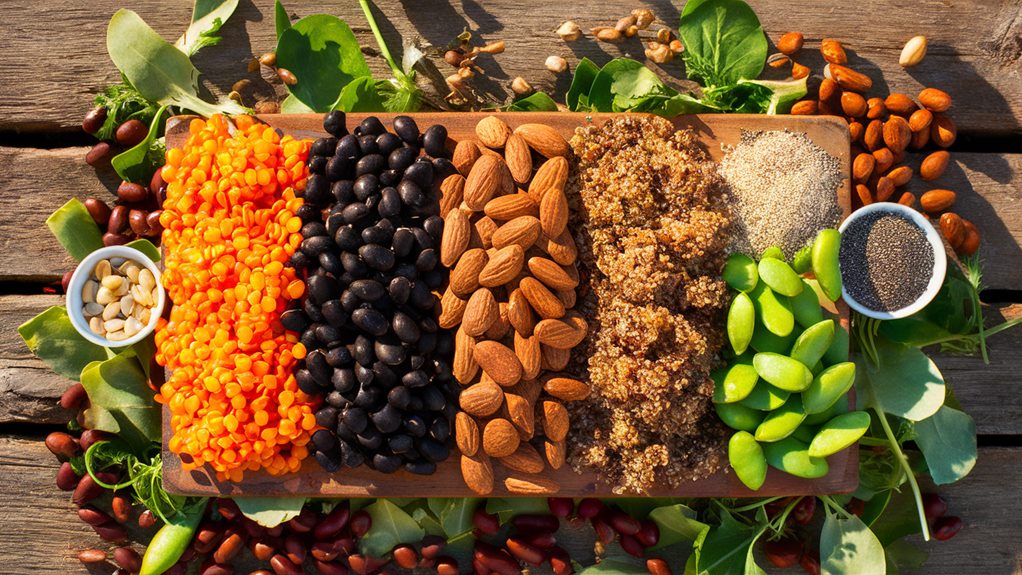If you're an athlete looking for plant-based protein sources, consider incorporating legumes, whole grains, nuts, and seeds into your diet. Legumes are rich in essential amino acids and fiber, while whole grains provide extra nutrients and satiety. Nuts and seeds add protein and healthy fats, making them perfect for snacks or smoothies. Additionally, plant-based protein powders offer a convenient option for shakes and meals. Don't overlook soy products like tofu and tempeh, which promote muscle recovery. Leafy greens and veggies are also nutrient-dense choices that hydrate and nourish. You'll discover even more great options ahead.
Key Takeaways
- Legumes and pulses offer high protein content, essential amino acids, and versatility in meals, making them a staple for athlete nutrition.
- Whole grains provide fiber and vital nutrients, supporting digestion and sustained energy levels essential for athletic performance.
- Nuts and seeds are rich in healthy fats, protein, and omega-3 fatty acids, contributing to heart health and overall wellness for athletes.
- Plant-based protein powders, like pea or hemp protein, are convenient for quick shakes or baking, supplying essential amino acids.
- Soy products, including tofu and tempeh, have a complete amino acid profile that supports muscle growth and recovery post-exercise.
Legumes and Pulses
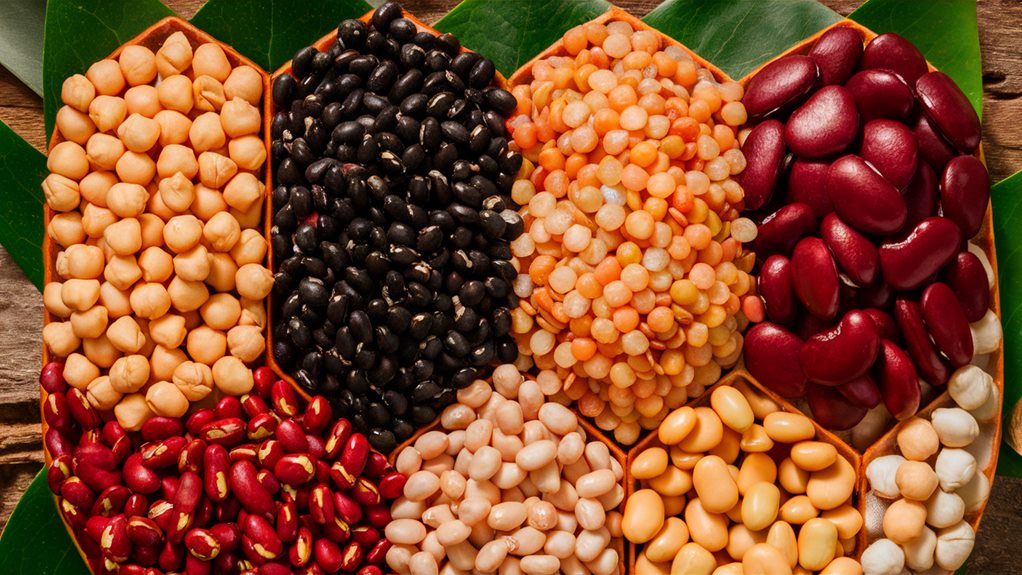
Legumes and pulses are some of the most accessible and nutrient-dense plant-based protein sources available to athletes. Packed with essential amino acids, fiber, vitamins, and minerals, they can markedly enhance your diet. For instance, beans, lentils, and chickpeas boast impressive nutrient profiles, offering high protein content along with complex carbohydrates that provide sustained energy. Incorporating these foods into your meals can help you meet your protein needs while fueling your workouts. Additionally, many plant-based foods are known for their environmental sustainability, making them a great choice for health-conscious athletes.
When it comes to cooking methods, versatility is key. You can enjoy legumes and pulses in various forms, whether you're adding them to soups, salads, or stews, or blending them into dips like hummus. One practical approach is to batch-cook beans or lentils at the beginning of the week, making it easier to incorporate them into your daily meals.
Canned options can also be a convenient choice—just rinse them to reduce sodium levels.
If you're looking for quick and nutritious meal ideas, try a black bean salad topped with avocado or a hearty lentil stew. These dishes not only taste great but also provide the protein and nutrients essential for your athletic performance. Plus, legumes and pulses are budget-friendly, making them a smart choice for athletes at any stage of their journey. So, embrace these protein-packed powerhouses and elevate your plant-based diet while feeling connected to a community that values health and wellness.
Whole Grains
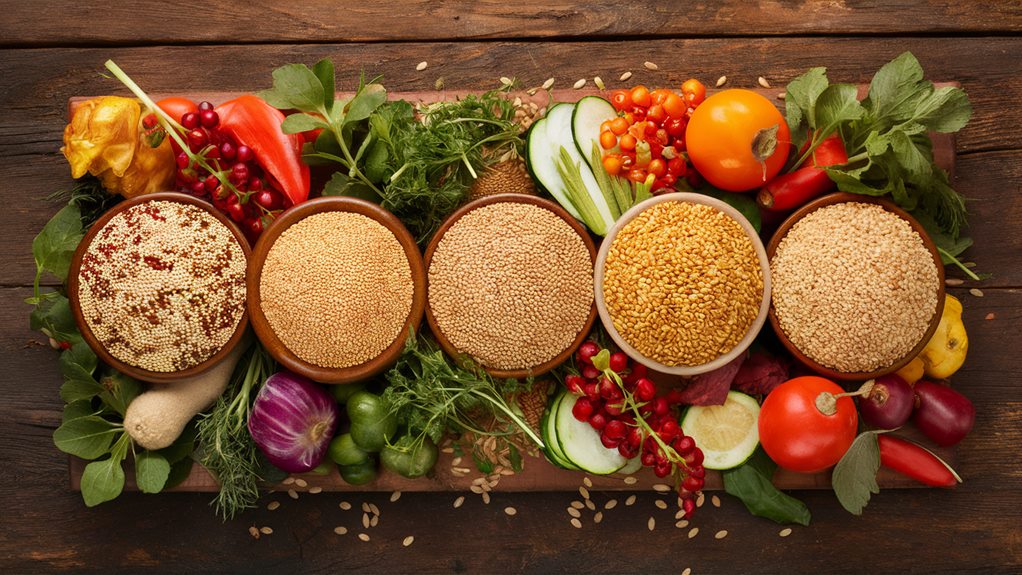
Whole grains are an essential component of a well-rounded diet for athletes, offering an array of nutrients that support both performance and recovery. Including whole grains in your meals can provide you with sustained energy and help maintain IDEAL health. Here's why they should be a staple in your diet:
- Rich in Fiber: Whole grains are packed with fiber, which aids digestion and helps keep you feeling full longer. Additionally, the right play mats can enhance your child's safety during active play, providing a supportive environment that mirrors the benefits of whole grains for athletes safety standards compliance.
- Nutrient-Dense: They provide essential vitamins and minerals like iron, magnesium, and B vitamins, ESSENTIAL for energy metabolism.
- Versatile Ingredients: Whole grains can be incorporated into countless dishes, making them easy to enjoy.
- Heart Health: Regularly consuming whole grains is linked to a lower risk of heart disease, keeping your body in top shape for performance.
When cooking whole grains, remember these tips: rinse grains before cooking to remove any debris, soak them overnight for quicker cooking times, and use vegetable broth instead of water for extra flavor. Quinoa, brown rice, and farro are excellent choices that can transform your meals.
Nuts and Seeds
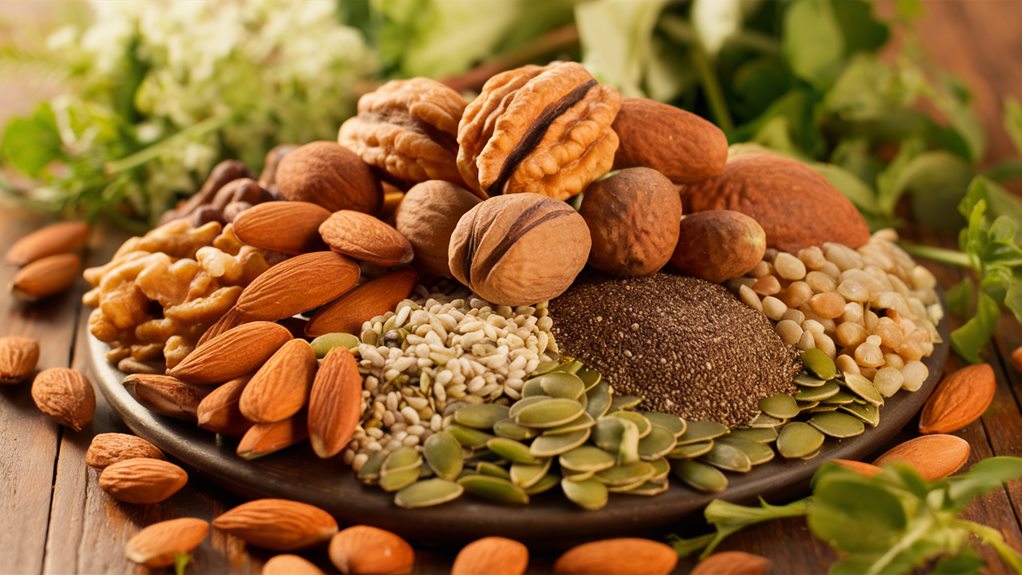
Incorporating nuts and seeds into your diet can further enhance your nutritional intake as an athlete. These powerhouse foods are packed with essential nutrients that support your performance and recovery, much like how organic fertilizers contribute to plant health and growth.
Nuts, like almonds, walnuts, and pistachios, are rich in healthy fats, protein, and fiber, while seeds such as chia, flaxseed, and pumpkin seeds provide additional protein and omega-3 fatty acids. These nutritional benefits make them an ideal choice for anyone looking to boost their plant-based protein sources.
When it comes to culinary uses, nuts and seeds are incredibly versatile. You can toss them into smoothies for added texture, blend them into nut butters, or sprinkle them over salads and oatmeal for a satisfying crunch. They also work well in energy bars and snacks, making them convenient for on-the-go athletes. Just a handful of nuts or a couple of tablespoons of seeds can enhance your meals while keeping your energy levels steady.
Incorporating nuts and seeds into your daily routine not only helps you meet your protein needs but also contributes to heart health, weight management, and overall wellness. They're an easy and delicious way to stay fueled and connected with a community that values nutritious eating. So, next time you're preparing a meal or snack, think about adding a variety of nuts and seeds to elevate your performance and nourish your body.
Plant-Based Protein Powders
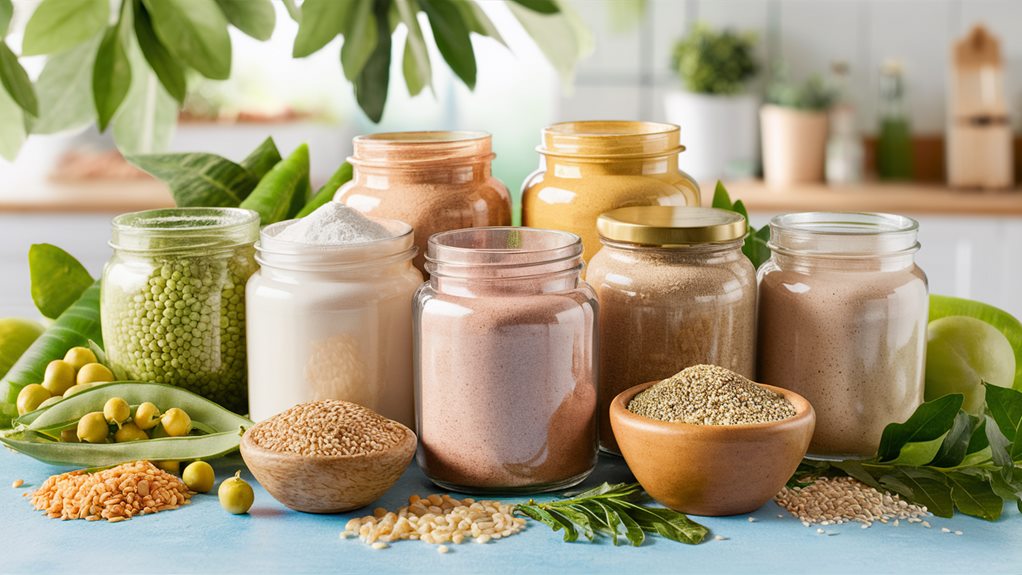
How can you guarantee you're getting enough protein to support your athletic performance? Plant-based protein powders can be a game changer. They're convenient, versatile, and packed with the nutrients your body needs. When choosing the right powder, consider the digestibility comparison among various options—some are easier on the stomach than others, so you'll want to pick one that suits your body.
Here are some reasons why you might love incorporating plant-based protein powders into your routine:
- Convenience: Quick and easy to mix into shakes or meals.
- Versatility: Perfect for smoothies, oatmeal, or even baking.
- Nutrient-dense: Packed with essential amino acids and vitamins.
- Flavor options: From chocolate to vanilla to berry, there's something for everyone!
When looking for a protein powder, explore options like pea protein, hemp protein, and brown rice protein. Each has its unique flavor profile and nutritional benefits. Plus, many brands now offer blends that enhance digestibility, making it easier to absorb those crucial nutrients.
Soy Products
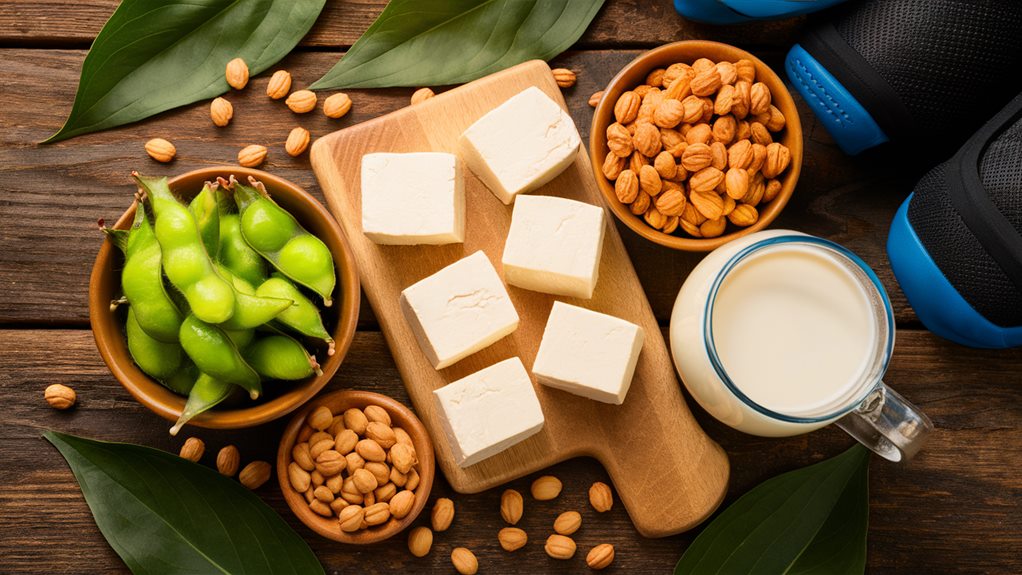
When it comes to plant-based protein sources, soy products stand out for their impressive nutritional profile and versatility in the kitchen. Packed with high-quality protein, soy offers a complete amino acid profile, making it an excellent choice for athletes. You'll find that soy protein benefits include promoting muscle growth and recovery, which is essential for your performance.
However, there are some common misconceptions about soy. Many worry about its effects on hormone levels, but research shows that moderate soy consumption is safe and can even be beneficial for most people. Incorporating soy into your diet can help you meet your protein needs without sacrificing taste or variety.
Cooking with soy is easier than you might think. Tofu, tempeh, and edamame are just a few options you can experiment with. Tofu absorbs flavors well, making it perfect for stir-fries or marinated dishes. Tempeh has a nutty flavor and works wonderfully in sandwiches or salads. Edamame is a great snack or addition to grain bowls.
For delicious recipes, try a tofu stir-fry with your favorite veggies and a savory sauce, or whip up a tempeh taco filling with spices and avocado. Remember to explore different cooking techniques like grilling and baking to keep things interesting. With these tips, you can easily incorporate soy products into your meals, ensuring you benefit from their fantastic nutritional qualities while enjoying a diverse, satisfying diet.
Leafy Greens and Vegetables
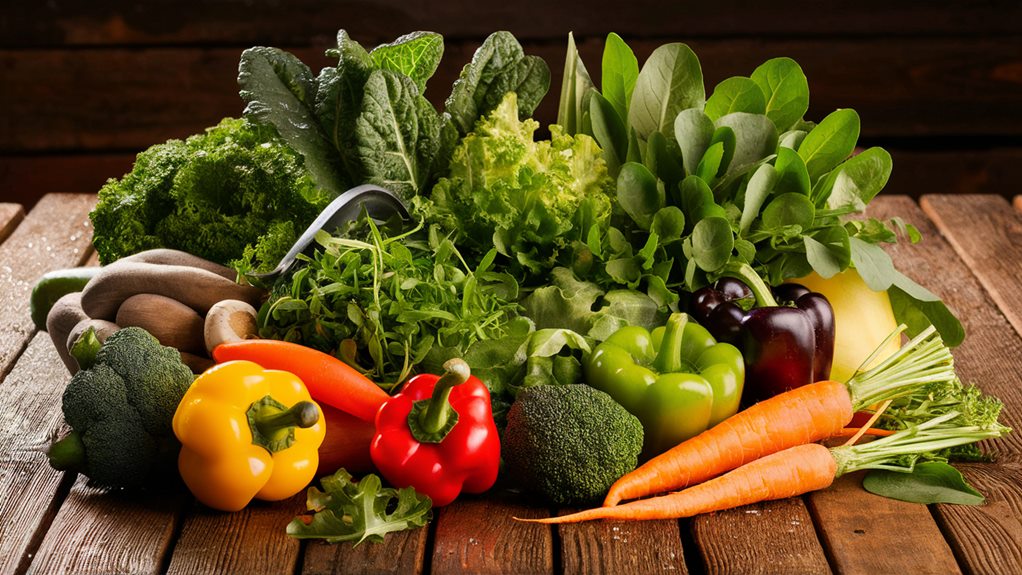
Leafy greens and vegetables are powerhouses of nutrition that can greatly enhance an athlete's diet. Not only do they provide essential vitamins and minerals, but they also offer a surprising amount of plant-based protein. Incorporating these vibrant foods into your meals can support your training and recovery, making you feel more energized and focused.
Here's why you should embrace leafy greens and veggies:
- Rich in antioxidants: They help combat oxidative stress from intense workouts.
- High in fiber: Great for digestion and keeping you full longer.
- Hydrating: Many greens have a high water content, helping you stay hydrated.
- Versatile: They can easily be added to smoothies, salads, or stir-fries.
To make the most of these nutrient-dense foods, consider experimenting with smoothie recipes that include spinach or kale. Blend them with fruits and a source of protein for a delicious post-workout drink. Additionally, meal prep ideas like roasting a variety of colorful vegetables can save you time during the week while ensuring you get the nutrition you need.
Don't underestimate the power of leafy greens and vegetables in your diet. They not only provide essential nutrients but also create a sense of belonging when shared with friends or teammates at a meal. So, go ahead and fill your plate with greens and enjoy the benefits they bring to your athletic performance!
Frequently Asked Questions
How Can I Combine Plant Proteins for Complete Amino Acids?
To combine plant proteins for complete amino acids, focus on protein combining. Pair legumes with grains, like beans and rice, to enhance absorption and make sure you're getting all essential amino acids.
This approach not only boosts your protein intake but also delivers various nutrients, offering numerous benefits for overall health. Experiment with different combinations in your meals, and you'll find it easier to meet your dietary needs while enjoying diverse and delicious options.
Are There Any Potential Allergens in These Protein Sources?
When exploring protein combinations, it's important to take into account potential allergens. Common plant-based sources like soy, nuts, and wheat can trigger allergic reactions in some individuals. To make sure safety, always check ingredient labels and be mindful of cross-contamination in food preparation. If you're unsure about your allergies, consult with a healthcare professional. This way, you can enjoy the benefits of plant proteins while minimizing any risk to your health and well-being.
How Can I Increase My Protein Intake on a Plant-Based Diet?
To increase your protein intake on a plant-based diet, focus on protein-rich snacks like hummus with veggies or nut butter on whole grain toast. Incorporating plant-based protein supplements such as pea protein powder in smoothies can also help.
Don't forget to explore legumes, lentils, and quinoa in your meals. By mixing these options throughout your day, you'll easily boost your protein levels while enjoying a variety of delicious foods!
Do Plant-Based Proteins Support Muscle Recovery as Effectively as Animal Proteins?
While animal proteins often boast complete amino acid profiles, plant-based proteins can still support muscle recovery effectively. By comparing amino acid profiles, you'll find that many plant sources provide essential nutrients, though some may lack one or two amino acids.
Examining digestion rates reveals that plant proteins can be digested more slowly, which might be beneficial for sustained recovery. Ultimately, with the right combinations, you can thrive on a plant-based diet and recover well.
What Are the Best Cooking Methods to Preserve Protein Content in Plants?
When it comes to preserving protein content in plants, certain cooking techniques make a big difference.
Steaming and microwaving are great protein preservation methods, as they cook food quickly without excessive heat.
Avoid boiling, which can leach nutrients, and instead focus on quick sautéing or roasting at lower temperatures.
These methods not only maintain protein levels but also enhance flavor, helping you enjoy nutritious meals while keeping your protein intake high.
Conclusion
Incorporating plant-based protein sources into your diet can greatly enhance your athletic performance. From legumes and whole grains to nuts, seeds, and soy products, you've got plenty of options to fuel your workouts. Remember, it's not just about quantity but quality, so mix and match to cover your amino acid needs. By embracing these nutritious foods, you'll be putting your best foot forward on your fitness journey. After all, variety is the spice of life!

